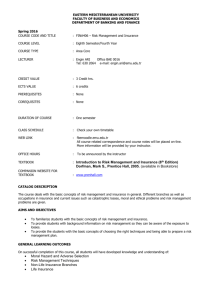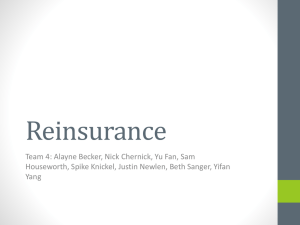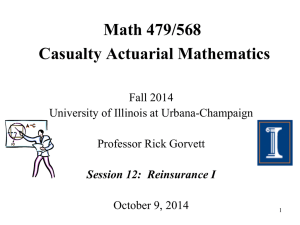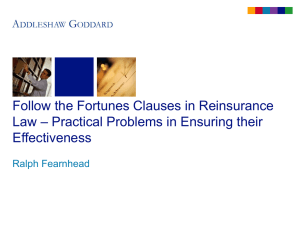Reinsurance Basics GeneralCologne Reinsurance
advertisement
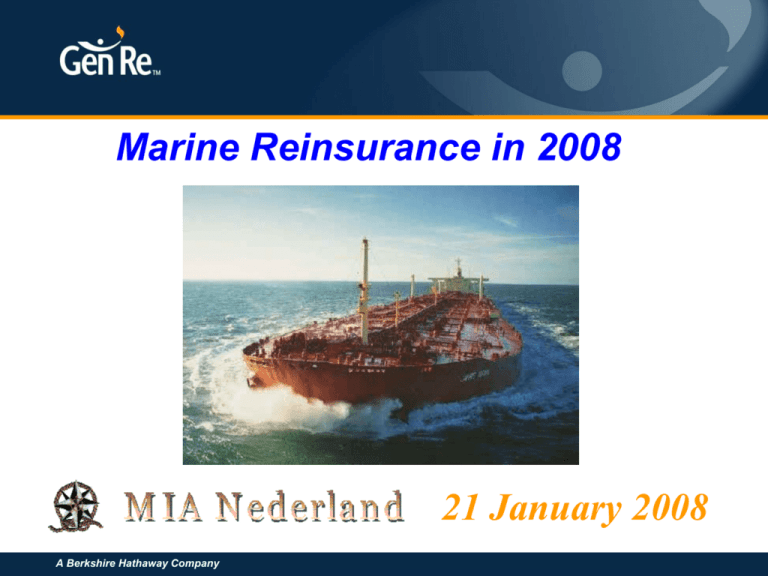
Marine Reinsurance in 2008 21 January 2008 A Berkshire Hathaway Company TABLE OF CONTENTS 1 Reinsurance Market 2 Basic Principles of Reinsurance 3 Issue’s and Trends 4 Pricing in the Future 2 1 Reinsurance Market The Insurance Industry – Simplified REINSURERS R/I BROKERS LLOYDS INSURERS Broker / Agent / Producer INSUREDS 3 1 Reinsurance Market Top Ten Global Property/Casualty Insurance Companies, by Revenues, 2006 US$ millions 1 1 2 2 3 3 4 4 5 5 6 6 7 7 8 8 9 9 10 10 Allianz Allianz American International Group American International Group Berkshire Hathaway Berkshire Hathaway Zurich Financial Services Zurich Financial Services State Farm Insurance Cos. State Farm Insurance Cos. Munich Re Group Munich Re Group Millea Holdings Millea Holdings Allstate Allstate Swiss Reinsurance Swiss Reinsurance Hartford Financial Services Hartford Financial Services Germany Germany U.S. U.S. U.S. U.S. Switzerland Switzerland U.S. U.S. Germany Germany Japan Japan U.S. U.S. Switzerland Switzerland U.S. U.S. $125,346 $125,346 $113,194 $113,194 $98,539 $98,539 $65,000 $65,000 $60,528 $60,528 $58,183 $58,183 $36,067 $36,067 $35,796 $35,796 $32,118 $32,118 $26,500 $26,500 (1) Based on an analysis of companies in the Global Fortune 500. Includes stock and mutual companies. (2) Revenues include premium and annuity income, investment income and capital gains or losses, but exclude deposits; includes consolidated subsidiaries, excludes excise taxes. Source: Fortune. 4 1 Reinsurance Market World Largest Reinsurance Brokers Source: Business Insurance, October 24, 2005 2005 Gross Revenues 2004 Gross Revenues 1 2 3 4 5 6 7 8 9 10 Aon Re Global Guy Carpenter & Co. Inc. Benfield Group Ltd. Willis Re Jardine Lloyd Thompson Towers Perrin Cooper Gay (Holdings) Ltd. BMS Group Gallagher Re John B. Collins $920,000,000 838,000,000 589,800,000 565,000,000 155,800,000 153,300,000 92,800,000 75,300,000 75,000,000 52,000,000 $940,000,000 868,000,000 558,300,000 550,000,000 145,200,000 146,000,000 57,550,000 73,000,000 78,000,000 48,100,000 % Change -2% -3% 16% 15% 7% 5% 2% 3% -4% 8% 3,000 2,606 1,700 1,159 433 N/A 475 200 311 377 5 1 Reinsurance Market Top 10 Global Reinsurers by total net written reinsurance premium – 2006 Source: S&P Global RI Highlights ( Sept 2007) 2006 Ranking Company 1 2 3 4 5 6 7 8 9 10 Munich Re, Germany Swiss Re, Switzerland General Re/Berkshire Hathaway, US Hannover Re, Germany Lloyd's of London, UK SCOR RI Group of America Everest Re Partner Re Transatlantic Holdings, US 2006 Net RI Premium Written ($ MM's) 25,432 23,841 11,576 9,353 8,445 4,885 4,343 3,875 3,689 3,633 * Property & Casualty + Life Premiums 6 1 Reinsurance Market Ratio of Reinsurer Loss & Underwriting Expense to Premiums Written, 1985-2006 1.26 1.06 1.01 1.17 1.13 1.18 1.14 1.06 1.02 1.03 1.10 1.08 1.08 1.09 Katrina, Rita, Wilma 0.95 1.0 Hurricane Andrew 1.07 1.1 1.06 1.10 1.2 Liability Crisis 1.07 1.3 1.21 Loss & LAE Ratio 1.4 1.07 1.5 Sept. 11 1.39 Despite the respite in 2006, reinsurers paid an average of $1.11 in loss and expense for every $1 in written premium since 1985 0.9 85 86 87 88 89 90 91 92 93 94 95 96 97 98 99 00 01 02 03 04 05 06 7 1 Reinsurance Market S&P Financial Strength Rating Changes Berkshire / General Re Swiss Re Chubb Re (Federal) AXA Re Everest Re Hannover Re Partner Re Transatlantic Re XL Re ACE Tempest Re W.R. Berkley Munich Re / American Re Renaissance Re Aspen Re Axis Specialty Employers Re / GE Re IPC Holdings Lloyd’s Endurance Re Montpelier Re PXRE SCOR Alea Converium Re AAA X AA+ AA AA- A+ A A- BBB+ X X X X X X X X X X X Watch / Outlook Stable Watch - Negative Stable Positive Stable Negative Stable Stable Stable Stable Stable Stable X X X X X X X X X X X X Stable Negative Stable Watch - Positive Negative Stable Positive Negative Stable Stable Stable Stable This chart was created by Gen Re solely for its use and that of its clients and should not be reproduced or distributed further Source: standardandpoors.com Ratings as of January 2006 8 1 Reinsurance Market Development of Corporate Capital at Lloyd’s PricewaterhouseCoopers Review 2002, updated 2005 90 80 70 60 50 40 Individual Corporate & other 30 20 10 0 19 94 19 95 19 96 19 97 19 98 19 99 20 00 20 01 20 02 20 03 20 04 % of Lloyd’s capacity 100 9 1 Reinsurance Market Suppliers of Lloyd’s Capital (2005) PricewaterhouseCoopers Review, 2002 updated Lloyds Annual Review, 2005 7% 14% Non-insurance industry 11% US insurance industry Bermudian insurance industry 17% Other insurance industry 34% Names' conversion capital Names (unlimited) 17% 62 Syndicates 1625 “Names” (Individual) 10 2 Basic Principles of Reinsurance WHAT IS “REINSURANCE ?” • A way to spread risk • A contract of indemnity between an Insurer and a Reinsurer • Original Insured - no contractual right or privity • Contract between two informed parties • Always transfer of risk 11 2 Basic Principles of Reinsurance Major Types of Reinsurance Facultative and Treaty Facultative • separate reinsurance contract negotiated on each risk FACULTATIVE HYBRID TREATY • No obligation on either party’s behalf to place or accept the risk Treaty • certain group or class of business reinsured under a single contract • Obligatory nature – if it “fits” the contract it must be ceded, and accepted. Pro Rata Quota Share Excess of Loss Surplus Share Per Risk Excess of Loss Per Risk Per Occurrence Aggregate Excess of Loss Per Risk Aggregate Excess of Loss 12 2 Basic Principles of Reinsurance Reasons to Buy Treaty Reinsurance • Spread of risk • Stabilization of underwriting results • Catastrophe relief (one occurrence affecting multiple policies, i.e., Hurricane Andrew) • Underwriting assistance • Premium capacity • Ease of use 13 2 Basic Principles of Reinsurance Reasons to Buy Fac Reinsurance • Large line capacity • Treaty-excluded business • Treaty protection • Accommodation for a good agent or insured • Catastrophe (a large loss affects one policy versus five) • Underwriting expertise • Flexibility 14 2 Basic Principles of Reinsurance Major Types of Reinsurance Pro Rata and Excess of Loss Pro Rata • also known as Proportional reinsurance FACULTATIVE HYBRID TREATY • insurance amount, premium and losses under a primary contract are shared between the ceding company and the reinsurer in an agreed proportion Pro Rata Excess of Loss Excess of Loss • also known as NonProportional reinsurance • reinsurer agrees to indemnify the ceding company for losses that exceed a specified retention up to an agreed-upon limit Quota Share Surplus Share Per Risk Excess of Loss Per Risk Per Occurrence Aggregate Excess of Loss Per Risk Aggregate Excess of Loss 15 2 Basic Principles of Reinsurance Pro Rata and Excess of Loss Non-Proportional or Excess of Loss Reinsurance Cession Proportional or shared Reinsurance Retention Cession (% or Line) Retention 16 2 Basic Principles of Reinsurance Pro Rata Reinsurance (Proportional) Pro Rata • How It Works • Three Types of Pro Rata Reinsurance Quota Share Reinsurer Participation 40% Company Participation 60% – Quota Share – Surplus Share – Contributing Excess 17 2 Basic Principles of Reinsurance Pro Rata Reinsurance (Proportional) • Retention expressed in $$. • Often referred to as a “line.” • Insurer retains 100% of risks up to Reinsurer Participation 75% Company Participation 25% Surplus Share the $$ amount of their “line.” • Cede all amounts in excess of that. 18 2 Basic Principles of Reinsurance Excess of Loss (XOL or Non-Proportional) • The reinsurer promises to reimburse the ceding company for losses that exceed the ceding company's retention Reinsurer Participation • The reinsurer reimburses the ceding company up to the reinsurance limit stipulated in the reinsurance contract • In return for this promise, the reinsurer charges the ceding company a premium Company Participation 19 2 Basic Principles of Reinsurance Excess of Loss Reducing the volatility. How does that work? Jumbo Losses: Rare, random, and virtually unpredictable.; usually relatively few exposures in portfolio Medium Losses: Some years more, some years less; can afford cost over time but need smoothing Small Losses: Large # of relatively predictable losses; very manageable with right tools Ideal is to keep the predictable and cede the volatile / unpredictable. 20 2 Basic Principles of Reinsurance Excess of Loss – marine pyramid view of a risk Total Loss Fire/Lightning/Explosion Machinery damage/small fire Theft/small fire/shortage 21 2 Basic Principles of Reinsurance Excess of Loss - Layering Often non proportional reinsurance coverage is layered, whereby the deductible of one layer is the sum of deductible and limit of liability of the underlying layer 8 7 6 2. XL: 3 mio xs 4 mio 5 4 3 1. XL: 2 mio xs 2 mio 2 1 deductible 0 22 2 Basic Principles of Reinsurance Excess of Loss – Layering - reasons • it is easier to place liabilities in smaller amounts • some smaller reinsurers specialise in particular levels of cover – lower/“working” layers, or – higher/“catastrophe” layers (“sleep easy”) • the nature and extent of risk is different at different levels of cover 23 2 Basic Principles of Reinsurance Excess of Loss – layering - reasons • layering therefore allows more accurate assessment of the appropriate XL premium • inclusions/ exclusions of specific classes (e.g. CXL treaties covering PA, WC/EL, MTPL, MOD etc) • different conditions for several layers – scope of protection – annual aggregate limits – reinstatements 24 2 Basic Principles of Reinsurance Excess of Loss - reinstatements • The limit of liability can be provided more than once e.g. 3 reinstatements for a risk layer and 1 for a cat layer • There is a maximum annual limit equal to the limit of liability plus the limit multiplied by the number of reinstatements • The reinstatement functions automatically when the original limit of liability or any part thereof is consumed by a loss • An additional premium is often charged for this reinstatement 25 2 Basic Principles of Reinsurance Excess of Loss – basis of coverage • The basis of coverage is specified in the contract and determines which losses the reinsurer is liable for: - Losses occurring during the reinsurance year - Risk attaching, i.e. losses arising under policies issued or renewed during the reinsurance year. 26 2 Basic Principles of Reinsurance Excess of Loss – basis of coverage Loss date 8.1.2000 original policy period: 1.4.99 - 31.3.2000 x 1999 2000 • Losses occurring basis: all reinsurers involved from 1.1.2000 to 31.12.2000 are liable • Risk Attaching basis: all reinsurers involved from 1.1.99 to 31.12.99 are liable 27 2 Basic Principles of Reinsurance EXCESS OF LOSS vs PRO RATA REINSURANCE Loss Treatment Comparison Pro Rata Excess Reinsurer Participation Reinsurer Company Participation Participation 40% 60% Reinsurer Participation 75% Company Participation 25% Limit $5M Company Retention $ 250,000 Excess of Loss Quota Share Surplus Share (3 Lines Retention) 28 2 Basic Principles of Reinsurance EXCESS OF LOSS vs PRO RATA REINSURANCE Loss Treatment Comparison Pro Rata Excess Reinsurer Company Participation Participation 40% 60% Reinsurer Participation 75% Loss $2M Reinsurer $1,750,000 $800,000 $1,200,000 $1,500,000 $500,000 Reinsurer Participation Company Participation 25% Limit $5M Company CompanyParticipation Retention $250,000 Excess of Loss Quota Share Surplus Share (3 Lines Cession) 29 3 Issue’s and Trends • Catastrophes • Security (Basel II) • Securitization 30 3 Issue’s and Trends U.S. Insured - Catastrophe Losses ($ Billions) $100 $56.8 $27.5 $4.6 00 $12.9 $8.3 99 $26.5 $10.1 $2.6 97 98 $7.4 96 $4.7 91 $8.3 $2.7 90 95 $7.5 89 $40 $16.9 $60 $5.5 $80 $22.9 2005 was by far the worst year ever for insured catastrophe losses in the US, but the worst has yet to come. $100 $5.9 $120 $20 $100 Billion CAT year is coming soon $ Billions 20?? 05 04 03 02 01 94 93 92 $0 Excludes $4B-$6b offshore energy losses from Hurricanes Katrina & Rita. Note: 2001 figure includes $20.3B for 9/11 losses reported through 12/31/01. Includes only business and personal property claims, business interruption and auto claims. Non-prop/BI losses = $12.2B. Source: Property Claims Service/ISO; Insurance Information Institute 31 3 Issue’s and Trends Share of Losses Paid by Reinsurers, by Disaster 70% 60% 50% 40% 30% Reinsurance is playing an increasingly important role in the financing of megaCATs; Reins. Costs are skyrocketing 30% 25% 60% 45% 20% 20% 10% 0% Hurricane Hugo (1989) Hurricane Andrew (1992) Sept. 11 Terror Attack (2001) 2004 Hurricane Losses 2005 Hurricane Losses 32 3 Issue’s and Trends S&P Financial Strength Rating Changes Berkshire / General Re Swiss Re Chubb Re (Federal) AXA Re Everest Re Hannover Re Partner Re Transatlantic Re XL Re ACE Tempest Re W.R. Berkley Munich Re / American Re Renaissance Re Aspen Re Axis Specialty Employers Re / GE Re IPC Holdings Lloyd’s Endurance Re Montpelier Re PXRE SCOR Alea Converium Re AAA X AA+ AA AA- A+ A A- BBB+ X X X X X X X X X X X X X X X X X X X X X X X Watch / Outlook Stable Watch - Negative Stable Positive Stable Negative Stable Stable Stable Stable Stable Stable Stable Negative Stable Watch - Positive Negative Stable Positive Negative Stable Stable Stable Stable This chart was created by Gen Re solely for its use and that of its clients and should not be reproduced or distributed further Source: standardandpoors.com Ratings as of January 2006 33 3 Issue’s and Trends Distribution of Capital Requirements A&E Risk 9% Asset Risk 8% Core Reserve Risk 32% Reinsurance Risk 24% CAT Risk 7% New Business Risk 19% Source: Moody’s Special Comment, Growing Reinsurance Risk Weighs on P & C Insurance Market Recovery, August 2003 34 3 Issue’s and Trends Increased Reinsurance Leverage Reinsurance Recoverables as % Industry Surplus 85% 80% 75% 70% 65% 60% 55% 50% 45% 40% 1998 1999 2000 2001 2002 Source: Moody’s Special Comment, Growing Reinsurance Risk Weighs on P & C Insurance Market Recovery, August 2003 35 3 Issue’s and Trends Moody’s “In the aftermath of a prolonged soft market for property and casualty insurance, the exposure of primary insurers to counterparty risk on reinsurance assets has become a key credit risk for the industry. Insurers that once gorged themselves at the trough of cheap reinsurance are finding their meal was anything but a free lunch. The ultimate tab has yet to be determined, but could well be much higher than insurers bargained for.” 36 3 Issue’s and Trends Moody’s “ In the face of these emerging concerns over reinsurance exposure, Moody’s is increasing analytic attention on reinsurance risk in our evaluation of ceding insurance firms, most notably in the context of assessing capital adequacy.” Source: Moody’s Special Comment, Growing Reinsurance Risk Weighs on P & C Insurance Market Recovery, August 2003 37 3 Issue’s and Trends Securitization: Or, why would an Insurer Securitize ? • Alternative to catastrophe reinsurance – Non-existent (reinsurance of last resort) – Scarce – Expensive • Multi-year nature • Collateralized : minimal / no credit risk • May seek no payback – “winner” takes all • Access to Capital markets • Motivated (intermediaries) determined to make a market 38 3 Issue’s and Trends Securitization – what is it? Two Common Examples • CAT Bonds (Ins. Linked Securities ) – Converts Ins risk to Securities form (capital market) • Indemnity based - parallels reinsurance • Indexed : (Industry L/R or Total Loss $$) = easier investor evaluation • Parametric loss = f (event magnitude, location) – EQ of magnitude 7.5 in California… – Windstorm w/ sustained windspeed of XX kph in … • Sidecars – Proportional structure 39 3 Issue’s and Trends CAT Bonds (ILS) • Sponsor – Insurer / Reinsurer* / Corporation • Issuer – – Bankruptcy remote Special Purpose Vehicle – R/I contract w/ Issuer – Issues CAT bonds & places proceeds in collateral account • Swap Counterparty – swaps investment returns to a LIBOR based rate. • Investors – Receive coupons (interest pmt) quarterly – No “event” = receive principal @maturity – “Event” = receive any remaining principal @ maturity 40 3 Issue’s and Trends SIDECARS • Capital market backing • Little / no infrastructure – easy to dismantle • Rely on other R/I’s to “manage” business • Quota Share structure (proportional) • Capital relief • “Flexibility” 41 4 Pricing in the Future Global Marine Premium 1999-2005 (US$ Million), as reported 20000 18000 16000 14000 12000 10000 8000 6000 4000 2000 0 1999 2000 2001 2002 2003 2004 2005 Accounting Year Global Hull Cargo Liability Energy Total 42 89 90 91 92 93 94 95 96 92.5 119.4 115.7 106.0 102.0 102.0 110.4 105.9 115.5 108.0 107.2 110.1 102.6 115.8 100.0 107.5 104.1 100.1 97.2 98.4 118.4 100.8 98.8 106.4 109.5 106.9 107.9 108.4 108.8 Combined Ratio: 89.6 92.4 97.3 114.2 109.2 118.2 109.6 4 Pricing in the Future Ocean Marine vs. All Lines Ocean Marine 97 98 99 00 01 02 03 All Lines 130 04 05 125 120 115 110 105 100 95 90 85 80 06* 43 4 Pricing in the Future Profitability Peaks & Troughs in the P/C Insurance Industry, 1975 – 2008F 25% 20% 15% 10% 5% 0% 75 76 77 78 79 80 81 82 83 84 85 86 87 88 89 90 91 92 93 94 95 96 97 98 99 00 01 02 03 04 05 06 07F 08F -5% 44 4 Pricing in the Future Effects of pricing Strategy • Scenario 1 Scenario 2 • (no reduction) (10% reduction) • POPeye the Sailor man Des Arster ex Ocean Marine Underwriter 2004 • ------------------------------------------------------------------- --------------------------------------------------------------- • NWP US$23m NWP US$20.7m • Expenses US$6m Expenses US$6m • Expected Losses US$13m Expected Losses US$13m • Expected Profit US$4m (83% CR) Expected Profit US$1.7m (92% CR) • Result • A 10% decrease in rates results in a 57% decrease ( diff between $1.7 & $4m) in expected • profit. 45 4 Pricing in the Future Effects of pricing Strategy • Scenario 3 Scenario 4 • • (Hold rate but losses 24% of business due to price) ----------------------------------------------------------------------- (Hold rate but lose 10% of business due to price) ----------------------------------------------------------------------- • NWP US$20.7m NWP US$17.5m • Expenses US$6m Expenses US$6m • Expected Losses US$11.7m Expected Losses US$9.9m • Expected Profit US$3m (85.5% CLR) Expected Profit US$2m (90% CLR) • Result • Better to lose 10% of your book and keep rates the same than to discount your book by 10%. • Would need to lose 24% of your book to match the expected profit from a 10% decrease in rate. 46 4 Pricing in the Future Burning Cost versus Exposure BURNING COST An estimate of the future loss cost based on the experience of solely one account. How it’s used Premium = Total claims over period divided by period = average loss cost + profit + expenses. Problem = net/gross/claims paid/outstanding/IBNR ? Pricing error = Ignoring similar account large losses (one account is too small a basis) . 47 4 Pricing in the Future Burning Cost versus Exposure Original Insured: Costa Lot Fleet. 5 bulkers, youngest 2001, oldest 1980. Year Premium Claims L/R 2001 300,000 200,000 67% 2002 250,000 300,000 120% 2003 310,000 250,000 81% Total 660,000 750,000 114% Renewal premium = Total claims 750,000 divided by 3 = ALC 250,000 250,000 + 35% (profit 15%, expenses 20%) = 337,500. Therefore renewal premium = 337,500 48 4 Pricing in the Future Burning Cost versus Exposure EXPOSURE RATING 1 An estimate of the future loss costs based on the experience from a large group of similar risks. How it’s used Statistical claims data over a “book” of similar risks+profit+expenses = rate. Problem = Selection error; Hull - vessel type, flag, large enough group. 49 4 Pricing in the Future Burning Cost versus Exposure Original Insured: Costa Lot Fleet. 5 bulkers, youngest 2001, oldest 1980. 2001 bulker, value 20,000,000 statistical (exposure) rate = 0.2% Prem. = 40,000 2000 bulker, value 17,500,000 statistical (exposure) rate = 0.222% Prem. = 38,850 1995 bulker, value 15,000,000 statistical (exposure) rate = 0.35% Prem. = 52,500 1985 bulker value 10,000,000 statistical (exposure) rate = 0.85% 85,000 Prem. = 1980 bulker, value 5,0000,000 statistical (exposure) rate = 1.25% Prem. = 62,500 Total loss cost = 278,850 + 35% = 376,447. 50 4 Pricing in the Future Burning Cost versus Exposure EXPOSURE RATING 2 An estimate of future loss cost based upon the estimation of volatility of layers without claims experience. Cost of capital. Expenses. Volatility charge when possibility of portfolio destabilization due to higher layer exposure. 51 4 Pricing in the Future Burning Cost versus Exposure * Both methods have there place. * The “Exposure” approach is far better suited to large, volatile risks. * The exposure method better suited on risks of which underwriter has little or no experience - new/no claims data. * Using the burning cost method to fine tune an exposure rate risk, can aid the individual risk assessment and pricing. 52 And Finally…… It is a difficult business but not a complicated one… “Unlike the situation prevailing in many other industries – neither size nor brand name determines an insurer’s profitability. Indeed, many of the biggest and best–known companies regularly deliver mediocre results. What counts in this business is underwriting discipline”. Warren E. Buffet Berkshire Hathaway 2001 Letter to Shareholders 53




